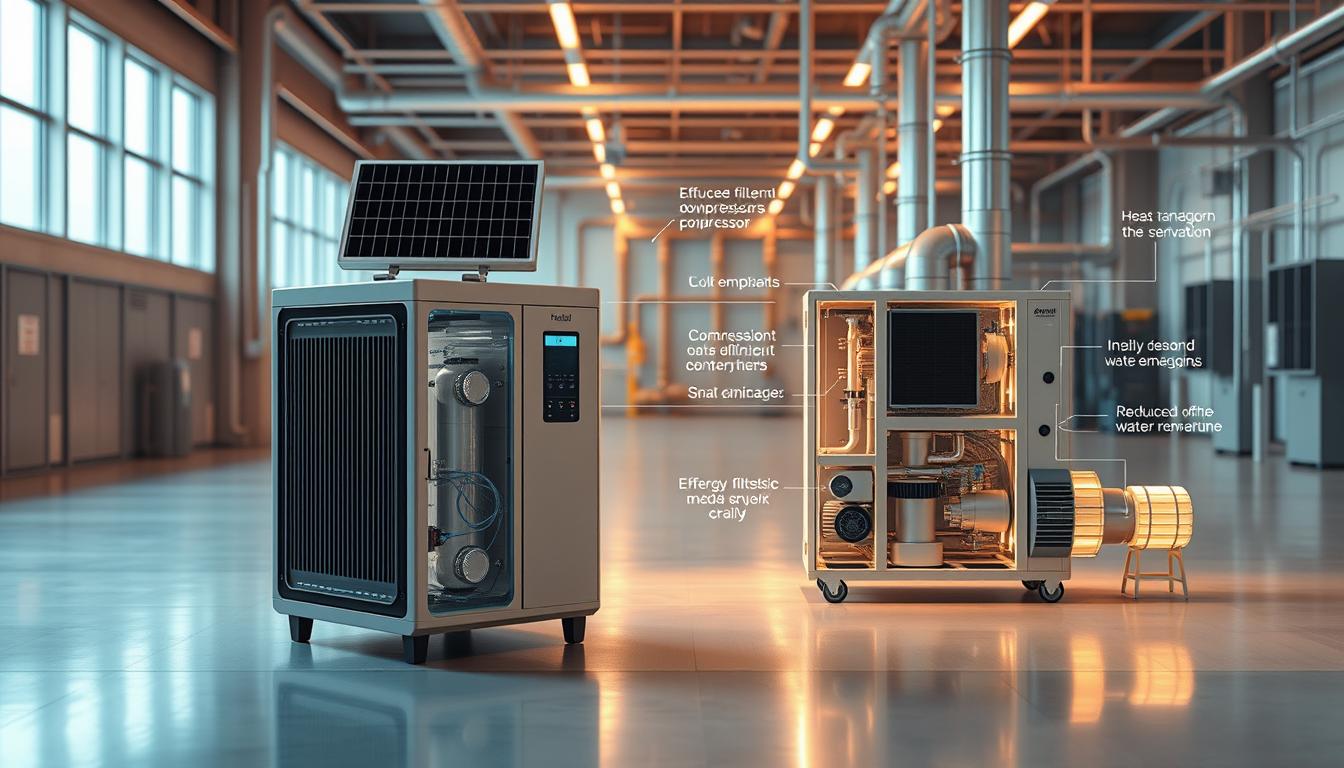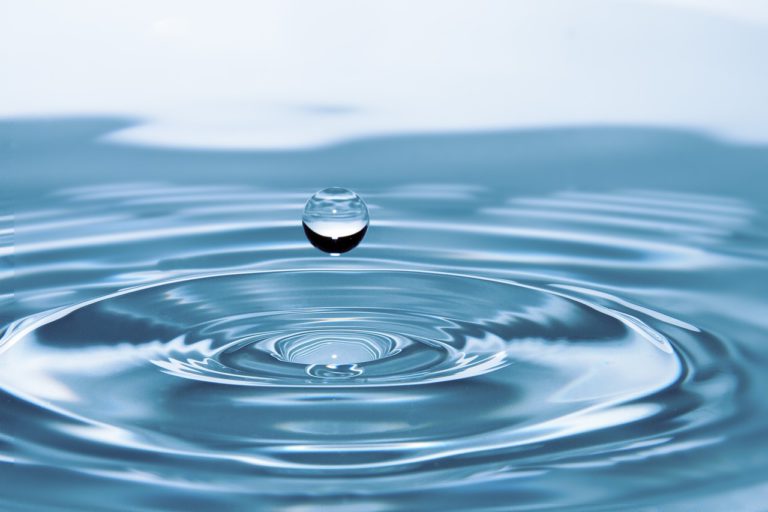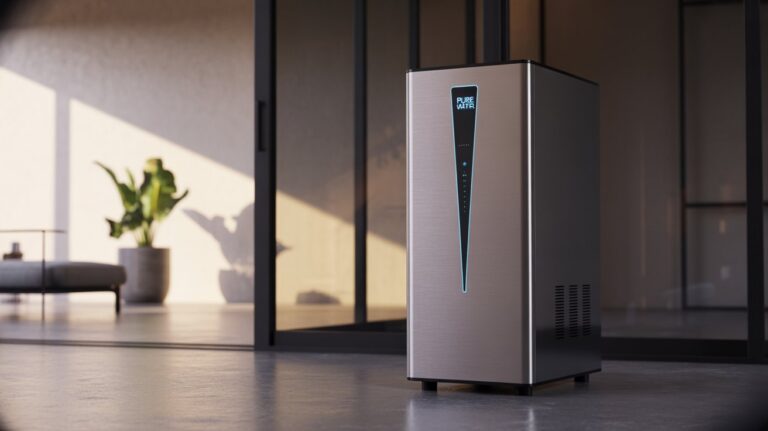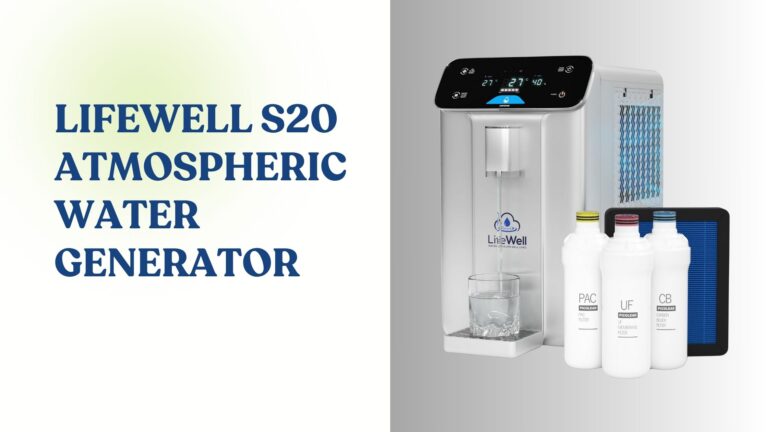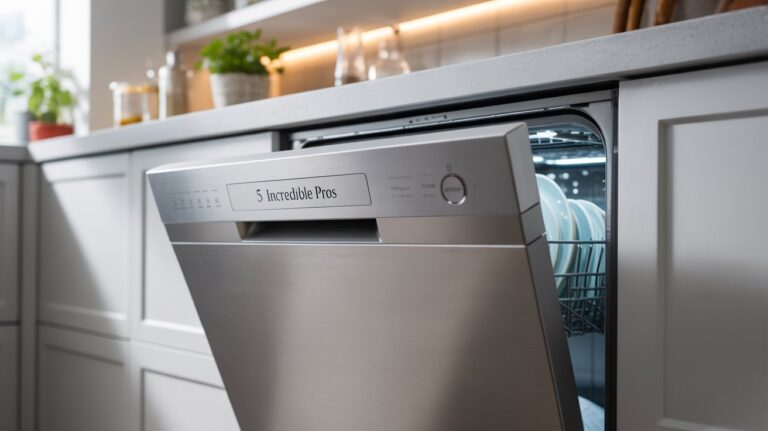How Much Energy Do Atmospheric Water Generators Use?
As the world grapples with water scarcity, innovative solutions like devices that extract moisture from the air are gaining attention. These devices produce clean drinking water, but their energy usage is a crucial aspect to consider.
Imagine having a device that can pull clean drinking water out of thin air, much like the steam on a window in winter. This is the promise of certain innovative technologies. However, understanding their efficiency is vital for assessing their environmental sustainability.
Key Takeaways
- Innovative devices can provide clean drinking water by extracting moisture from the air.
- The energy usage of these devices is crucial for their efficiency and sustainability.
- Understanding energy consumption is vital for assessing environmental impact.
- Energy-efficient solutions are being developed to mitigate environmental concerns.
- Sustainable clean water production is a significant global challenge.
What Are Atmospheric Water Generators?
Atmospheric water generators (AWGs) are machines designed to extract water from the air, providing a sustainable source of clean drinking water. These devices are particularly useful in areas where access to clean water is limited.
Definition and Basic Principles
AWGs work on the principle of extracting moisture from the air, similar to how a dehumidifier operates. The process involves drawing in humid air, cooling it to its dew point, and then collecting the condensed water.
How Water Is Extracted from Air
The extraction process typically involves cooling condensation units or desiccant-based systems. Cooling condensation units cool the air to its dew point, causing the water vapor to condense into liquid water. Desiccant-based systems, on the other hand, use a desiccant material to absorb moisture from the air, which is then heated to release the water vapor, condensed, and collected.
Types of Atmospheric Water Generators
There are primarily two types of AWGs: cooling condensation units and desiccant-based systems. The choice between them depends on the ambient humidity and temperature conditions.
Cooling Condensation Units
Desiccant-Based Systems
| Type | Operating Principle | Energy Consumption |
|---|---|---|
| Cooling Condensation Units | Cool air to dew point | High |
| Desiccant-Based Systems | Use desiccant to absorb moisture | Moderate to High |
Reducing energy consumption in these systems is crucial for making them more eco-friendly and sustainable. Efforts to improve their energy efficiency can significantly impact their overall environmental footprint.
The Science Behind Extracting Water from Air
Understanding the science behind Atmospheric Water Generators (AWGs) is crucial for appreciating their potential in addressing water scarcity. AWGs are devices that harvest water from the air, even in arid regions, by leveraging the process of condensation.
Condensation Process
The condensation process is fundamental to how AWGs operate. It involves cooling the air to its dew point, causing the water vapor to condense into liquid water. This process is akin to how air conditioning systems work, where moisture in the air condenses on the cooling coils.
Dew Point and Temperature Differential
The efficiency of the condensation process depends significantly on the dew point and the temperature differential between the air and the cooling surface. A larger differential facilitates more efficient condensation. For instance, in humid environments, the dew point is higher, making it easier to condense water vapor into liquid.
Humidity Requirements
Humidity is a critical factor in the operation of AWGs. These devices can extract water from the air even at relatively low humidity levels, but their efficiency increases with higher humidity. Understanding the optimal humidity conditions is essential for maximizing water production.
Optimal Conditions for Water Generation
Optimal conditions for water generation vary depending on the type of AWG and its technology. Generally, higher humidity and temperatures closer to the dew point enhance the efficiency of water generation. The table below summarizes the optimal conditions for different types of AWGs.
| AWG Type | Optimal Humidity | Optimal Temperature |
|---|---|---|
| Refrigeration-based AWG | 60-80% | 20-30°C |
| Desiccant-based AWG | 40-60% | 15-25°C |
By understanding and optimizing these conditions, sustainable atmospheric water systems can be designed to maximize water production while minimizing energy consumption, thereby enhancing their overall efficiency and environmental sustainability.
Components of an Atmospheric Water Generator
The functionality of an atmospheric water generator depends on its core components, which work together to extract and purify water from air. These systems are designed to be efficient, producing clean drinking water while minimizing energy consumption.
Air Filtration System
The air filtration system is crucial for removing contaminants from the air before it reaches the condensation coils. As noted by industry experts, “Effective filtration is key to ensuring the quality of the water produced.” The process involves capturing dry contaminants, thereby protecting the system and ensuring clean water output.
Contaminant Removal Process
The contaminant removal process involves filtering the air introduced to the refrigerated coils to capture dry contaminants. This step is vital for preventing the introduction of pollutants into the water generation process.
Condensation Chamber
The condensation chamber is where the actual extraction of water from air occurs. This process relies on cooling elements and materials that facilitate the condensation of water vapor into liquid water.
Cooling Elements and Materials
The choice of cooling elements and materials significantly impacts the efficiency of the condensation process. Advanced materials and designs help in reducing the energy consumption of water from air machines.
Water Treatment System
After condensation, the water treatment system further purifies the water, making it safe for drinking. This involves processes such as purification and mineralization to enhance the water quality.
Purification and Mineralization
Purification removes any remaining contaminants, while mineralization adds back beneficial minerals, resulting in clean and healthy drinking water. As a result, atmospheric water generators can provide a reliable source of clean drinking water, supporting low-energy atmospheric water solutions.
Atmospheric Water Generator Energy Consumption Explained
Understanding the energy consumption of AWGs is essential for evaluating their viability as a sustainable water source. The energy efficiency of these devices varies widely based on their design, technology, and operating conditions.
Average Energy Usage Metrics
The average energy consumption of AWGs is typically measured in kWh per liter of water produced. This metric provides a standardized way to compare the efficiency of different models.
kWh per Liter of Water
Studies have shown that the energy consumption of AWGs can range from 0.3 to 1.2 kWh per liter, with some high-efficiency models achieving even lower consumption rates. For instance, at 25°C and 70% humidity, a particular AWG model consumes around 50 W per liter.
Energy Consumption by Generator Type
Different types of AWGs exhibit varying levels of energy efficiency. The technology used, such as thermoelectric cooling or heat exchange systems, significantly impacts energy consumption.
Comparing Efficiency Across Technologies
Efficient water generation technology is crucial for minimizing the energy footprint of AWGs. For example, some models incorporating advanced condensation techniques or solar power can achieve lower energy consumption. When comparing different AWGs, it’s essential to consider the specific technology used and its impact on atmospheric water generator energy consumption.
By understanding these factors, users can make informed decisions about the most energy-efficient AWG for their needs.
Factors Affecting Energy Efficiency in Water Generators
Understanding the factors that affect energy efficiency is crucial for optimizing AWG performance. The efficiency of these systems is influenced by a combination of environmental conditions and design elements.
Ambient Temperature Impact
Ambient temperature plays a significant role in AWG energy efficiency. Temperature fluctuations can affect the condensation process, thereby influencing overall performance.
Seasonal Variations in Performance
Seasonal changes in temperature can lead to variations in AWG performance. For instance, hotter climates require more energy to cool the system, potentially reducing efficiency.
Humidity Levels
Humidity is another critical factor. Higher humidity levels can increase water production but may also impact energy consumption.
Regional Considerations
Regional humidity variations necessitate AWG designs tailored to specific environmental conditions.
Machine Design and Technology
The design and technology used in AWGs also affect energy efficiency. Advanced compressor technology and insulation can significantly reduce energy consumption.
Compressor Efficiency and Insulation
Efficient compressors and proper insulation are key to minimizing energy loss and maximizing overall system performance.
Comparing Energy Usage: AWGs vs. Traditional Water Sources
As the world looks for sustainable ways to access clean water, understanding the energy footprint of AWGs compared to traditional sources is crucial. AWGs offer a unique solution for water generation, but their energy usage must be evaluated against that of conventional water supply methods.
Municipal Water Systems
Municipal water systems involve significant energy costs, primarily due to treatment and distribution processes.
Treatment and Distribution Energy Costs
The energy required to treat and distribute water from municipal systems can be substantial. According to the U.S. Environmental Protection Agency (EPA), water treatment and distribution account for approximately 2% of the total energy consumed in the United States.
Bottled Water
Bottled water is another traditional water source that has a considerable energy footprint, mainly due to production and transportation.
Production and Transportation Energy Footprint
The production of bottled water involves energy-intensive processes, including manufacturing bottles, filling, and packaging. Additionally, transporting bottled water over long distances further increases its energy footprint. A study by the Natural Resources Defense Council found that bottled water production requires around 1.39 kilowatt-hours (kWh) of electricity per liter.

Well Water Systems
Well water systems, which involve extracting water from underground aquifers, also have energy requirements, primarily for pumping and purification.
Pumping and Purification Energy Requirements
The energy needed to pump and purify well water can vary significantly depending on the depth of the well and the quality of the water. Deeper wells require more energy to pump water to the surface, and additional treatment processes can further increase energy consumption.
In conclusion, while AWGs have their own energy requirements, they offer a potentially more sustainable option compared to traditional water sources, especially when considering the environmental impact of bottled water and the energy-intensive processes involved in municipal and well water systems.
Innovations in Energy-Efficient Atmospheric Water Generation
The quest for sustainable water generation has led to significant innovations in energy-efficient atmospheric water generation. As the global demand for clean water continues to rise, the development of more efficient Atmospheric Water Generators (AWGs) is becoming increasingly crucial.
Solar-Powered AWGs
Solar-powered AWGs represent a significant advancement in reducing the energy consumption of water generation. By harnessing solar energy, these systems can operate with minimal reliance on grid electricity, making them ideal for remote or off-grid locations.
Hybrid Systems and Energy Storage
Hybrid solar AWGs that incorporate energy storage solutions, such as batteries, can provide a stable and continuous water supply even during periods of low sunlight. This technology enhances the reliability and efficiency of solar-powered water generation.
Heat Recovery Systems
Heat recovery systems are another innovation that improves the energy efficiency of AWGs. These systems capture and reuse the heat generated during the water generation process, reducing the overall energy required.
Utilizing Waste Heat for Improved Efficiency
By utilizing waste heat, AWGs can significantly lower their energy consumption. This approach not only reduces operational costs but also minimizes the environmental impact of water generation.
Smart Technology Integration
The integration of smart technology into AWGs has opened new avenues for optimizing energy efficiency. Advanced sensors and monitoring systems enable real-time adjustments to operational parameters, ensuring that the AWG operates at peak efficiency.
AI-Driven Optimization Algorithms
AI-driven optimization algorithms can analyze data from various sensors and adjust the operation of the AWG to minimize energy consumption while maximizing water production. This technology represents a significant step forward in the quest for energy-efficient water generation.
Some domestic water generator manufacturers claim that the energy consumption of their AWGs is comparable to running a desktop computer or a small space heater, highlighting the potential for energy-efficient solutions in this field.
Cost Analysis: Operating an Atmospheric Water Generator
To assess the feasibility of atmospheric water generators, it’s essential to examine their operating expenses. These devices offer a sustainable solution for clean water, but understanding their cost implications is vital for potential users.
Electricity Costs
The primary operational expense for atmospheric water generators is electricity. The cost varies based on the device’s energy efficiency and local electricity rates.
Regional Rate Variations
Electricity costs can differ significantly across regions. For instance, areas with high renewable energy penetration may offer lower rates, reducing operational costs.
Maintenance Expenses
Regular maintenance is crucial for the longevity and efficiency of atmospheric water generators. This includes filter replacements and servicing.
Filter Replacement and Servicing
Filter replacement is a significant maintenance cost. The frequency and cost of filter changes depend on the generator’s design and usage.
Return on Investment Considerations
When evaluating atmospheric water generators, it’s essential to consider the return on investment (ROI). Customers can expect savings on energy costs and a payback period of less than 5 years for a device lifespan of 20 years.
Break-Even Analysis
A break-even analysis helps determine when the initial investment is offset by savings. This analysis is critical for understanding the long-term financial benefits of atmospheric water generators.
| Cost Component | Initial Cost | Annual Cost |
|---|---|---|
| Electricity | $0 | $500 |
| Maintenance | $0 | $200 |
| Total | $0 | $700 |
By understanding the various cost components, users can make informed decisions about adopting atmospheric water generators. These devices not only provide clean water but also offer long-term financial benefits through reduced energy and maintenance costs.
Environmental Impact of AWG Energy Consumption
The eco-friendly potential of Atmospheric Water Generators (AWGs) hinges on their energy consumption patterns and operational efficiency. As the world leans towards sustainable solutions, understanding the environmental footprint of AWGs is crucial for their effective deployment.
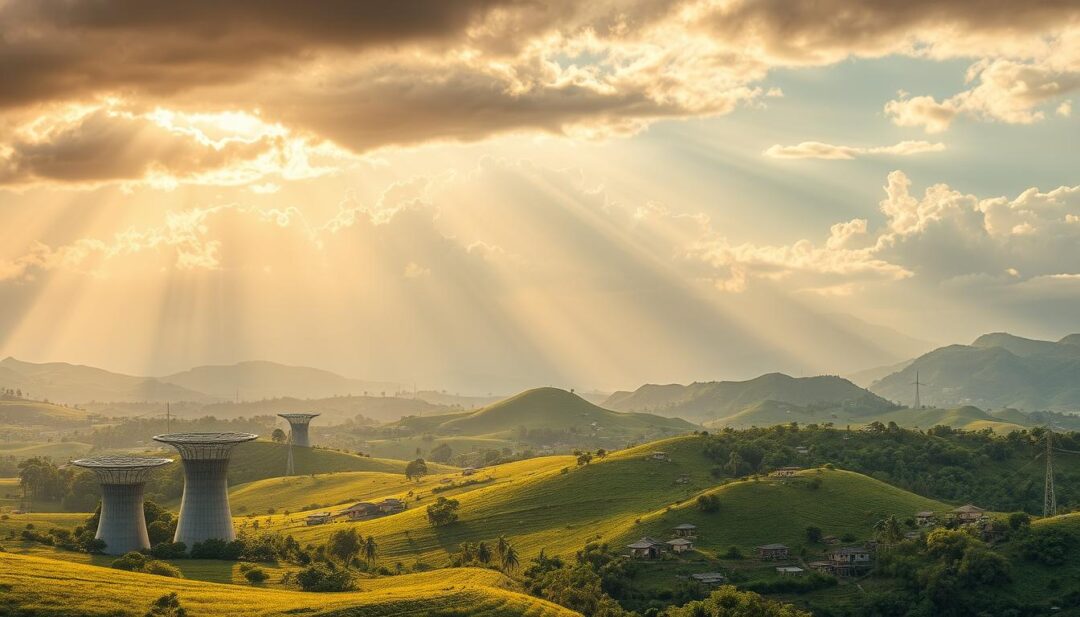
Carbon Footprint Analysis
AWGs can operate using various energy sources, including solar, electric, and thermal energy, which significantly influences their carbon footprint. A comprehensive Life Cycle Assessment (LCA) is essential to evaluate the overall environmental impact, from production to operation.
Life Cycle Assessment
LCA involves analyzing the environmental impacts associated with all stages of an AWG’s life, from raw material extraction through manufacturing, usage, and eventual disposal or recycling. This assessment helps identify areas where improvements can be made to reduce the overall carbon footprint.
“The true measure of sustainability lies not just in the technology itself, but in its entire lifecycle impact.” –
Sustainability Considerations
To enhance the sustainability of AWGs, it’s crucial to consider the integration of renewable energy sources. Solar-powered AWGs, for instance, offer a significant reduction in carbon emissions compared to traditional energy sources. Moreover, advancements in technology have led to more energy-efficient models, further minimizing their environmental impact.
Renewable Energy Integration Potential
The potential for integrating AWGs with renewable energy sources is vast. By harnessing solar or wind energy, AWGs can operate with a significantly reduced carbon footprint. This integration not only enhances their eco-friendliness but also improves their viability in remote or off-grid locations.
For more information on the benefits of AWGs, visit our detailed guide on exploring the benefits of atmospheric water.
Energy Efficiency Standards and Certifications
With the growing adoption of atmospheric water generators, the focus on energy efficiency standards and certifications is more relevant than ever. As these devices become more prevalent in both residential and commercial settings, understanding their energy consumption and efficiency becomes crucial.
ENERGY STAR and Similar Programs
ENERGY STAR is a well-known program that certifies energy-efficient products, including atmospheric water generators. To qualify for ENERGY STAR certification, AWGs must meet specific energy efficiency standards set by the U.S. Environmental Protection Agency.
Compliance Requirements
Manufacturers must ensure their AWGs comply with these standards by undergoing testing and verification processes. This involves meeting certain performance metrics related to energy consumption and water production efficiency.
Industry Benchmarks
Besides ENERGY STAR, industry benchmarks play a significant role in evaluating the performance of AWGs. These benchmarks often include metrics on energy consumption per liter of water produced.
Performance Metrics and Testing Protocols
Performance metrics for AWGs include energy consumption rates under various operating conditions. Testing protocols are established to ensure that AWGs are evaluated under standardized conditions, providing a fair comparison across different models.
| Certification Program | Key Metrics | Benefits |
|---|---|---|
| ENERGY STAR | Energy consumption per liter of water | Reduced energy costs, environmental benefits |
| Industry Benchmarks | Water production efficiency, energy usage | Improved product design, competitive advantage |
Real-World Applications and Case Studies
The versatility of atmospheric water generators is evident in their wide range of applications, from residential to humanitarian use cases. These devices are not only providing clean drinking water but are also doing so with a focus on energy efficiency, which is crucial for reducing overall atmospheric water generator energy consumption.
Residential Use Cases
In residential settings, atmospheric water generators are becoming increasingly popular for their ability to provide clean drinking water directly from air. Home AWG systems are designed to be compact and energy-efficient, making them suitable for household use.
Home AWG Systems and Their Performance
Home AWG systems have been reported to perform well in various climates, with some models capable of producing up to 30 liters of clean water per day. Their performance is often influenced by ambient humidity and temperature.
Commercial Applications
Commercial applications of AWGs include office buildings and the hospitality sector, where they provide a reliable source of clean water. For instance, Dodger Stadium uses AWG water for irrigating planting beds and trees around the stadium, showcasing their potential in large-scale applications.
Office Buildings and Hospitality Sector
In office buildings and hotels, AWGs serve as a sustainable alternative to bottled water, reducing plastic waste and reliance on municipal water supplies. Their low-energy atmospheric water solutions are particularly appealing in environments where energy efficiency is a priority.
Humanitarian and Disaster Relief Scenarios
AWGs play a critical role in humanitarian and disaster relief scenarios by providing off-grid water generation solutions. These devices can be deployed in areas affected by natural disasters or in remote communities lacking access to clean water.
Off-Grid Water Generation Solutions
Off-grid AWG solutions are particularly valuable in regions where traditional water infrastructure is lacking or has been compromised. Their ability to operate independently makes them a vital tool in emergency response situations.
Conclusion
Atmospheric water generators offer a promising solution to address water scarcity, providing clean drinking water while minimizing environmental impact. By understanding the factors that influence their energy consumption, we can optimize their performance and create more sustainable atmospheric water systems.
Efficient water generation technology is crucial in reducing the energy footprint of these devices. As innovations continue to emerge, such as solar-powered AWGs and smart technology integration, the potential for sustainable water production increases. By adopting energy-efficient atmospheric water generators, we can reduce our reliance on traditional water sources and mitigate the environmental impact associated with them.
The future of water generation lies in developing and implementing efficient, sustainable technologies that can meet the growing demand for clean drinking water. By investing in these solutions, we can create a more water-secure world while minimizing our environmental footprint.
Frequently Asked Questions
How much energy do atmospheric water generators typically consume?
What factors affect the energy efficiency of atmospheric water generators?
How do atmospheric water generators compare to traditional water sources in terms of energy usage?
What are some innovations in energy-efficient atmospheric water generation?
How can I reduce the energy consumption of my atmospheric water generator?
Are there any energy efficiency standards or certifications for atmospheric water generators?
Can atmospheric water generators be powered by renewable energy sources?
What is the average cost of operating an atmospheric water generator?
How much energy do atmospheric water generators typically consume?
What factors affect the energy efficiency of atmospheric water generators?
How do atmospheric water generators compare to traditional water sources in terms of energy usage?
What are some innovations in energy-efficient atmospheric water generation?
How can I reduce the energy consumption of my atmospheric water generator?
Are there any energy efficiency standards or certifications for atmospheric water generators?
Can atmospheric water generators be powered by renewable energy sources?
What is the average cost of operating an atmospheric water generator?
Frequently Asked Questions
How much energy do atmospheric water generators typically consume?
The energy consumption of atmospheric water generators varies depending on the type and size of the device, as well as the ambient temperature and humidity levels. On average, these devices can consume between 100-500 watts of electricity per hour, with some models using as little as 50 watts or as much as 1,000 watts.
What factors affect the energy efficiency of atmospheric water generators?
The energy efficiency of atmospheric water generators is affected by several factors, including ambient temperature, humidity levels, machine design, and technology used. For example, devices that use advanced materials and smart technology integration can be more energy-efficient than traditional models.
How do atmospheric water generators compare to traditional water sources in terms of energy usage?
Atmospheric water generators can be more energy-efficient than traditional water sources, such as bottled water, which requires significant energy for production, transportation, and storage. However, they may consume more energy than municipal water systems, which often use economies of scale to reduce energy costs.
What are some innovations in energy-efficient atmospheric water generation?
Some innovations in energy-efficient atmospheric water generation include solar-powered AWGs, heat recovery systems, and smart technology integration. These technologies can help reduce energy consumption and improve overall efficiency.
How can I reduce the energy consumption of my atmospheric water generator?
To reduce the energy consumption of your atmospheric water generator, you can optimize its placement to maximize airflow, maintain the device regularly, and adjust settings to match ambient conditions. Additionally, using energy-efficient models or upgrading to newer, more efficient technology can also help.
Are there any energy efficiency standards or certifications for atmospheric water generators?
Yes, there are energy efficiency standards and certifications for atmospheric water generators, such as ENERGY STAR and industry benchmarks. These programs help ensure that devices meet certain energy efficiency standards and provide consumers with a way to compare the energy efficiency of different models.
Can atmospheric water generators be powered by renewable energy sources?
Yes, atmospheric water generators can be powered by renewable energy sources, such as solar or wind power. This can help reduce their carbon footprint and make them more sustainable.
What is the average cost of operating an atmospheric water generator?
The average cost of operating an atmospheric water generator depends on several factors, including the device’s energy consumption, local electricity rates, and maintenance expenses. On average, the cost can range from
FAQ
How much energy do atmospheric water generators typically consume?
The energy consumption of atmospheric water generators varies depending on the type and size of the device, as well as the ambient temperature and humidity levels. On average, these devices can consume between 100-500 watts of electricity per hour, with some models using as little as 50 watts or as much as 1,000 watts.
What factors affect the energy efficiency of atmospheric water generators?
The energy efficiency of atmospheric water generators is affected by several factors, including ambient temperature, humidity levels, machine design, and technology used. For example, devices that use advanced materials and smart technology integration can be more energy-efficient than traditional models.
How do atmospheric water generators compare to traditional water sources in terms of energy usage?
Atmospheric water generators can be more energy-efficient than traditional water sources, such as bottled water, which requires significant energy for production, transportation, and storage. However, they may consume more energy than municipal water systems, which often use economies of scale to reduce energy costs.
What are some innovations in energy-efficient atmospheric water generation?
Some innovations in energy-efficient atmospheric water generation include solar-powered AWGs, heat recovery systems, and smart technology integration. These technologies can help reduce energy consumption and improve overall efficiency.
How can I reduce the energy consumption of my atmospheric water generator?
To reduce the energy consumption of your atmospheric water generator, you can optimize its placement to maximize airflow, maintain the device regularly, and adjust settings to match ambient conditions. Additionally, using energy-efficient models or upgrading to newer, more efficient technology can also help.
Are there any energy efficiency standards or certifications for atmospheric water generators?
Yes, there are energy efficiency standards and certifications for atmospheric water generators, such as ENERGY STAR and industry benchmarks. These programs help ensure that devices meet certain energy efficiency standards and provide consumers with a way to compare the energy efficiency of different models.
Can atmospheric water generators be powered by renewable energy sources?
Yes, atmospheric water generators can be powered by renewable energy sources, such as solar or wind power. This can help reduce their carbon footprint and make them more sustainable.
What is the average cost of operating an atmospheric water generator?
The average cost of operating an atmospheric water generator depends on several factors, including the device’s energy consumption, local electricity rates, and maintenance expenses. On average, the cost can range from $0.05 to $0.50 per liter of water produced.
How do atmospheric water generators impact the environment?
Atmospheric water generators can have a positive impact on the environment by providing clean drinking water and reducing reliance on traditional water sources. However, their energy consumption can contribute to greenhouse gas emissions, so it’s essential to choose energy-efficient models and consider renewable energy sources.
Frequently Asked Questions
How much energy do atmospheric water generators typically consume?
The energy consumption of atmospheric water generators varies depending on the type and size of the device, as well as the ambient temperature and humidity levels. On average, these devices can consume between 100-500 watts of electricity per hour, with some models using as little as 50 watts or as much as 1,000 watts.
What factors affect the energy efficiency of atmospheric water generators?
The energy efficiency of atmospheric water generators is affected by several factors, including ambient temperature, humidity levels, machine design, and technology used. For example, devices that use advanced materials and smart technology integration can be more energy-efficient than traditional models.
How do atmospheric water generators compare to traditional water sources in terms of energy usage?
Atmospheric water generators can be more energy-efficient than traditional water sources, such as bottled water, which requires significant energy for production, transportation, and storage. However, they may consume more energy than municipal water systems, which often use economies of scale to reduce energy costs.
What are some innovations in energy-efficient atmospheric water generation?
Some innovations in energy-efficient atmospheric water generation include solar-powered AWGs, heat recovery systems, and smart technology integration. These technologies can help reduce energy consumption and improve overall efficiency.
How can I reduce the energy consumption of my atmospheric water generator?
To reduce the energy consumption of your atmospheric water generator, you can optimize its placement to maximize airflow, maintain the device regularly, and adjust settings to match ambient conditions. Additionally, using energy-efficient models or upgrading to newer, more efficient technology can also help.
Are there any energy efficiency standards or certifications for atmospheric water generators?
Yes, there are energy efficiency standards and certifications for atmospheric water generators, such as ENERGY STAR and industry benchmarks. These programs help ensure that devices meet certain energy efficiency standards and provide consumers with a way to compare the energy efficiency of different models.
Can atmospheric water generators be powered by renewable energy sources?
Yes, atmospheric water generators can be powered by renewable energy sources, such as solar or wind power. This can help reduce their carbon footprint and make them more sustainable.
What is the average cost of operating an atmospheric water generator?
The average cost of operating an atmospheric water generator depends on several factors, including the device’s energy consumption, local electricity rates, and maintenance expenses. On average, the cost can range from
FAQ
How much energy do atmospheric water generators typically consume?
The energy consumption of atmospheric water generators varies depending on the type and size of the device, as well as the ambient temperature and humidity levels. On average, these devices can consume between 100-500 watts of electricity per hour, with some models using as little as 50 watts or as much as 1,000 watts.
What factors affect the energy efficiency of atmospheric water generators?
The energy efficiency of atmospheric water generators is affected by several factors, including ambient temperature, humidity levels, machine design, and technology used. For example, devices that use advanced materials and smart technology integration can be more energy-efficient than traditional models.
How do atmospheric water generators compare to traditional water sources in terms of energy usage?
Atmospheric water generators can be more energy-efficient than traditional water sources, such as bottled water, which requires significant energy for production, transportation, and storage. However, they may consume more energy than municipal water systems, which often use economies of scale to reduce energy costs.
What are some innovations in energy-efficient atmospheric water generation?
Some innovations in energy-efficient atmospheric water generation include solar-powered AWGs, heat recovery systems, and smart technology integration. These technologies can help reduce energy consumption and improve overall efficiency.
How can I reduce the energy consumption of my atmospheric water generator?
To reduce the energy consumption of your atmospheric water generator, you can optimize its placement to maximize airflow, maintain the device regularly, and adjust settings to match ambient conditions. Additionally, using energy-efficient models or upgrading to newer, more efficient technology can also help.
Are there any energy efficiency standards or certifications for atmospheric water generators?
Yes, there are energy efficiency standards and certifications for atmospheric water generators, such as ENERGY STAR and industry benchmarks. These programs help ensure that devices meet certain energy efficiency standards and provide consumers with a way to compare the energy efficiency of different models.
Can atmospheric water generators be powered by renewable energy sources?
Yes, atmospheric water generators can be powered by renewable energy sources, such as solar or wind power. This can help reduce their carbon footprint and make them more sustainable.
What is the average cost of operating an atmospheric water generator?
The average cost of operating an atmospheric water generator depends on several factors, including the device’s energy consumption, local electricity rates, and maintenance expenses. On average, the cost can range from $0.05 to $0.50 per liter of water produced.
How do atmospheric water generators impact the environment?
Atmospheric water generators can have a positive impact on the environment by providing clean drinking water and reducing reliance on traditional water sources. However, their energy consumption can contribute to greenhouse gas emissions, so it’s essential to choose energy-efficient models and consider renewable energy sources.
How do atmospheric water generators impact the environment?
.05 to
FAQ
How much energy do atmospheric water generators typically consume?
The energy consumption of atmospheric water generators varies depending on the type and size of the device, as well as the ambient temperature and humidity levels. On average, these devices can consume between 100-500 watts of electricity per hour, with some models using as little as 50 watts or as much as 1,000 watts.
What factors affect the energy efficiency of atmospheric water generators?
The energy efficiency of atmospheric water generators is affected by several factors, including ambient temperature, humidity levels, machine design, and technology used. For example, devices that use advanced materials and smart technology integration can be more energy-efficient than traditional models.
How do atmospheric water generators compare to traditional water sources in terms of energy usage?
Atmospheric water generators can be more energy-efficient than traditional water sources, such as bottled water, which requires significant energy for production, transportation, and storage. However, they may consume more energy than municipal water systems, which often use economies of scale to reduce energy costs.
What are some innovations in energy-efficient atmospheric water generation?
Some innovations in energy-efficient atmospheric water generation include solar-powered AWGs, heat recovery systems, and smart technology integration. These technologies can help reduce energy consumption and improve overall efficiency.
How can I reduce the energy consumption of my atmospheric water generator?
To reduce the energy consumption of your atmospheric water generator, you can optimize its placement to maximize airflow, maintain the device regularly, and adjust settings to match ambient conditions. Additionally, using energy-efficient models or upgrading to newer, more efficient technology can also help.
Are there any energy efficiency standards or certifications for atmospheric water generators?
Yes, there are energy efficiency standards and certifications for atmospheric water generators, such as ENERGY STAR and industry benchmarks. These programs help ensure that devices meet certain energy efficiency standards and provide consumers with a way to compare the energy efficiency of different models.
Can atmospheric water generators be powered by renewable energy sources?
Yes, atmospheric water generators can be powered by renewable energy sources, such as solar or wind power. This can help reduce their carbon footprint and make them more sustainable.
What is the average cost of operating an atmospheric water generator?
The average cost of operating an atmospheric water generator depends on several factors, including the device’s energy consumption, local electricity rates, and maintenance expenses. On average, the cost can range from $0.05 to $0.50 per liter of water produced.
How do atmospheric water generators impact the environment?
Atmospheric water generators can have a positive impact on the environment by providing clean drinking water and reducing reliance on traditional water sources. However, their energy consumption can contribute to greenhouse gas emissions, so it’s essential to choose energy-efficient models and consider renewable energy sources.
.50 per liter of water produced.
How do atmospheric water generators impact the environment?
Atmospheric water generators can have a positive impact on the environment by providing clean drinking water and reducing reliance on traditional water sources. However, their energy consumption can contribute to greenhouse gas emissions, so it’s essential to choose energy-efficient models and consider renewable energy sources.

